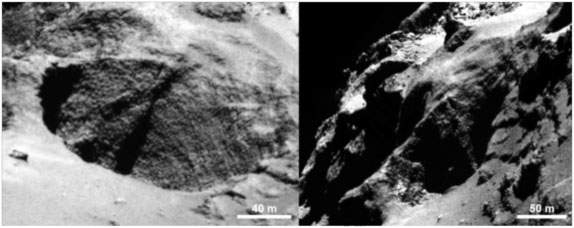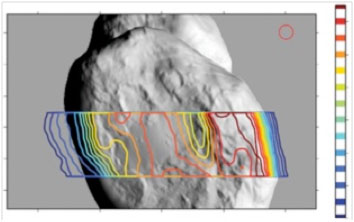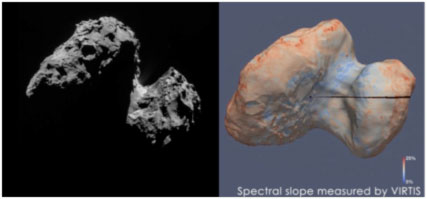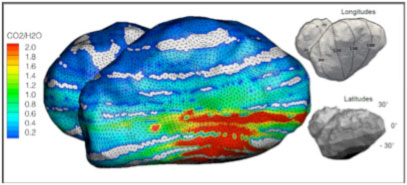The nucleus of 67P/Churyumov-Gerasimenko
The images of comet 67P acquired by the OSIRIS camera indicate an unusual doumbell shape, made up of two lobes separated by a « neck » whose origin has yet to be explained. Its surface, whose composition is essentially homogeneous, bears witness to a wide diversity of geological structures resulting from erosion, collapse and redeposition. The activity of the comet, rather surprising at such a large distance from the Sun, is at present limited to the « neck » region. The available images have enabled a three-dimensional model of the comet to be made, together with the detailed topography of the original landing site of Philae. Knowing the mass of the comet, this model has led to the first ever direct determination of the density of a cometary nucleus : it suggests a very high degree of porosity. This model also provides the « cartographic » context needed to interpret the results of the other experiments.

The surface properties of 67P/Churyumov-Gerasimenko
The MIRO instrument has enabled scientists to map the temperature of the immediate subsurface layers of 67P. It undergoes seasonal and daily temperature variations, which imply that the thermal conductivity of the surface of 67P is is weak, as a consequence of its porous and not very dense structure. The scientists have also measured the rate of production of water by the comet.. This changes as the comet rotates, the water emitted by the comet being essentially limited to the « neck » region.

A comet rich in organic material
Organic material on a cometary nucleus has been detected for the first time by Virtis. Its spectroscopic measurements indicate the presence of various substances containing carbon-hydrogen and/or oxygen-hydrogen links ; the hydrogen-nitrogen link has so far not been detected. These species are associated with opaque minerals such as iron sufides (pyrrhotite or troïlite). These measurements indicate moreover that no ice-rich area larger than about twenty metres has been detected in the regions illuminated by the Sun, which suggests that the immediate subsaurface layers down to a depth of several cm are significantly dehydrated.

The birth of the cometary magnetosphere
With the help of the RPC-ICA (Ion Composition Analyser) instrument, the scientists have have followed the evolution of water ions, from the first detection up to the time when the cometary atomosphere started to hinder the solar wind (at a distance of about 3,3 AU ). They have in this way managed to register the spatial configuration of the preliminary interaction between the solar wind and the rarefied cometary atmosphere , which leads to the creation of the magnetosphere of « Tchouri ».
67P/Churyumov-Gerasimenko, a witness to the birth of the Solar System
Born rougjly 4,5 billion years ago and frozen since, comets comets have conserved traces of the primitive material from which the Solar System was made. The chemical composition of their nuclei and their comas thus carry clues about the physical and chemical conditions of the early solar system. The ROSINA instrument on Rosetta has measured the composition of the coma of 67P (the coma is in a sense a rather dense atmospherela surrounding the nucleus, and is made up of a mixture of dust and gaseous molecules) as the comet rotates. These results suggest that thecomposition of heterogeneous coma undegoes considerable fluctuations, with a ratherr complex nuceleus-coma interaction in which the seasonal variations could be due to temperature variations just underr the cometary surface.

The dust of comet 67P/Churyumov-Gerasimenko
The dust detector GIADA has already reaped a harvest of data (size, speed, direction, composition) on the 0.1 to several millimetre size rane dust s emitted by the nucleaus. Furtherrmore, the OSIRIS images have led to the detection of larger dust grains in orbit arund the nucleus, which were probably emitted during preceding passages of the comet.
The following French laboratoires are involved in this work :
- Laboratoire d’astrophysique de Marseille (CNRS/ Aix-Marseille Université)
- Laboratoire d’études spatiales et d’instrumentation en astrophysique (Observatoire de Paris/CNRS/UPMC/Université Paris Diderot)
- Laboratoire atmosphères, milieux, observations spatiales (CNRS/UPMC/UVSQ)
- Institut de recherche en astrophysique et planétologie (CNRS/Université Toulouse III – Paul Sabatier)
- Laboratoire de physique et de chimie de l’environnement et de l’espace (CNRS/Université d’Orléans)
- Institut de planétologie et astrophysique de Grenoble (CNRS/Université Joseph Fourier)
- Laboratoire d’études du rayonnement et de la matière en astrophysique et atmosphères (Observatoire de Paris/CNRS/UPMC/ENS/Université de Cergy-Pontoise)
- Institut d’astrophysique spatiale (CNRS/Université Paris-Sud)
- Centre de recherches pétrographiques et géochimiques (CNRS/Université de Lorraine)
References
- Subsurface properties and early activity of comet 67P/Churyumov-Gerasimenko. S.Gulkis et al., Science, 23 janvier 2015.
- 67P/Churyumov-Gerasimenko : The Organic-rich surface of a Kuiper Belt comet as seen by VIRTIS/Rosetta. F. Capaccioni et al., Science, 23 janvier 2015.
- On the nucleus structure and activity of comet 67P/Churyumov-Gerasimenko. H. Sierks et al., Science, 23 janvier 2015.
- The Morphological Diversity of Comet 67P/Churyumov-Gerasimenko. N.Thomas et al., Science, 23 janvier 2015.
- Dust Measurements in the Coma of Comet 67P/Churyumov-Gerasimenko Inbound to the Sun Between 3.7 and 3.4 AU. A. Rotundi et al., Science, 23 janvier 2015.
- Birth of a comet magnetosphere : A spring of water ions. H. Nilsson et al., Science, 23 janvier 2015.
- Time variability and heterogeneity in the coma of 67P/Churyumov-Gerasimenko. M. Hässig et al., Science, 23 janvier 2015.
